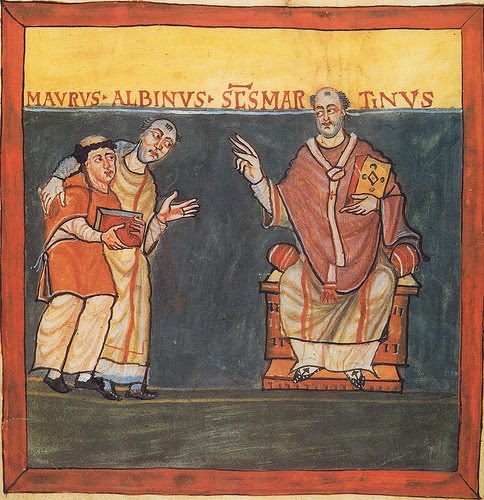 The Vatican Information Service reports, 3 June 2009:
The Vatican Information Service reports, 3 June 2009:
At his general audience this morning, Benedict XVI dedicated his catechesis to Rabanus Maurus, abbot of the monastery of Fulda, archbishop of Mainz and “praeceptor Germaniae”. The audience, held in St. Peter’s Square, was attended by more than 17,000 people.
Rabanus, born in the city of Mainz about the year 780, entered a Benedictine monastery at an early age where, “with his exceptional capacity for work, he contributed perhaps more than others to keeping alive, and in part also to developing with his own gifts, that theological, exegetical and spiritual culture from which succeeding centuries would draw”. Thanks to his “extraordinary culture”, he was an “advisor to princes”. And despite being elected as abbot of Fulda and later as archbishop of Mainz, he was able “to continue his studies, demonstrating with the example of his own life that it is possible to be … at the service of others without depriving oneself of time for reflection, study and meditation. Thus was Rabanus Maurus an exegete, philosopher, poet, pastor and man of God”.
“His works”, the Pope explained, “fill fully six volumes of Migne’s Latin Patrology. In all probability one of the most beautiful and well-known hymns of the Latin Church is due to him: ‘Veni Creator Spiritus’, an extraordinary summary of Christian pneumatology”. One of Rabanus’ most important texts is the “De laudibus Sanctae Crucis” in which he uses poetry “as well as pictorial forms within the manuscript itself. … This method, … which comes from the East, touched unequalled heights in the illuminated manuscripts of the Bible and in other works of faith and art that flowered in Europe until the invention of printing, and even afterwards”.
In Rabanus Maurus we see “an extraordinary awareness of the need to involve not only the mind and heart in the experience of faith, but also the senses”. This he accomplished by using “other aspects” such as “aesthetic taste and human sensitivity which bring man to benefit from the truth with all of himself: ‘spirit, soul and body. This is very important because faith is not just thought, faith comprehends our entire being”, said the Holy Father.
Author also of the “Carmina” which he intended should be used in the liturgy, Rabanus “did not dedicate himself to poetry as an end in itself, … rather he employed art, and all other forms of knowledge, for a deeper understanding of the Word of God”. Thus he was concerned “with introducing his contemporaries, above all ministers (bishops, priests and deacons), to an understanding of the profoundly theological and spiritual significance of all elements of liturgical celebration”. And, given that the Word of God is an integral part of the liturgy, throughout his life Rabanus Maurus “produced appropriate exegesis for nearly all the books of the Old and New Testaments, with clearly pastoral aims”.
This pastoral side of his character is also highlighted by his “Penitentiaries” in which, “in keeping with the sensibility his time, he listed sins and their corresponding punishments using, as far as possible, motivations drawn from the Bible, from the decisions of the Councils and from papal decrees”. Other of his pastoral works include “De disciplina ecclesiastica” and “De institutione clericorum”, in which “he explained the fundamental elements of Christian faith to the common people and clergy of his diocese”.
“I believe that Rabanus Maurus also speaks to us today”, Pope Benedict concluded. “Whether immersed in the frenetic rhythms of work or on holiday, we must reserve time for God. … We must not forget Sunday as the day of the Lord and the day of the liturgy, in order to see – in the beauty of our churches, of sacred music, and of the Word of God – the beauty of God Himself, and allow it to enter our own being. Thus our lives become great, they become true life”.
